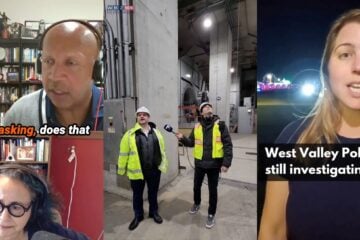First scripted series from PBS Digital Studios updates Frankenstein for modern age
BEVERLY HILLS, Calif. — You have to love the irony. The first scripted narrative series from PBS Digital Studios is a modern update of Frankenstein, the science-fiction classic about creating new life.
Just as in Mary Shelley’s timeless Gothic tale, PBS Digital Studios is using the latest in science and technology in its experiments to breathe new life into PBS programming.
PBS Digital Studios, launched in March 2012, will premiere Frankenstein M.D. Aug. 19, rolling out new episodes, each five to eight minutes long, on its YouTube channel every Tuesday and Friday. Fittingly enough, the 24-episode series will conclude Oct. 31.
The series and PBS Digital Studios itself is the latest effort by the public television service to introduce itself to a younger generation of viewers, 18- to 34-year-olds who are increasingly consuming video on mobile devices.
Launched with “Mister Rogers Remixed,” a catchy hit that went viral, PBS Digital Studios now offers more than 30 original series, many of them co-productions with public television stations. It has more than 1.2 million YouTube subscribers.
Co-produced with Pemberley Digital, the upcoming Frankenstein M.D. combines a modern take on the story with educational nuggets about related topics such as stem cells, cloning and 3-D printing. Pemberley has already attracted a young following on the Internet with modern versions of Pride & Prejudice (The Lizzie Bennet Diaries) and Emma (Emma Approved).
“Frankenstein M.D. will appeal to passionate audiences of literary-minded women ages 13 to 34,” Matthew Graham, senior director of PBS Digital Studios, said at the annual summer Television Critics Association press tour here earlier this week.
“We’ve packed Frankenstein M.D. with accurate, cutting-edge science content so that it educates while it inspires,” he said.
Graham, who joined PBS in 2008 to help build its online video player, said PBS Digital Studios arose from a desire to keep PBS relevant to teens and young adults who may have grown up with Sesame Street and Mister Rogers but who no longer watch many series on TV sets.
“We want to be the brand we’ve always been, with smart content for the intellectually curious,” Graham told Current. “We want to be that brand, and the first step for us was figuring out how to do that on YouTube. We want to grow that slate of shows, and we want to grow that audience.”
With a small budget, PBS Digital Studios initially focused on helping local stations find original content. “Sometimes we help them with some production funding; sometimes it’s just some kind of audience development strategy and promotion work.”
Before long, PBS’s YouTube channels started filling up with station-produced shows vaguely reminiscent of the peculiar cable-access series that materialized in city after city after the granting of cable franchises. Among these Digital Studios series are BBQ with Franklin, a mouth-watering Texas series, and Making Friends with Ryan Miller, about a New York rock musician who relocates to rural New Hampshire.
Next came a series spun off from a regular PBS series. On Everything But the News, Steve Goldbloom, a former NewsHour employee, plays a bumbling cub reporter for NewsHour assigned to cover the tech scene in San Francisco. “Journalistically, we’re not breaking stories, but there’s actually some good reporting in there,” Graham said.
Frankenstein M.D. is the next big step. Filmed in Los Angeles with a documentary feel, the updated version focuses on Victoria Frankenstein (Anna Lore), a Ph.D. and medical student. With her colleague, Iggy DeLacey (Steve Zaragoza), and her mentor Dr. Waldman (Kevin Rock), the ambitious Victoria makes a series of shocking and potentially dangerous discoveries.
Victoria and other characters will live both in the series and on social media.
“Because the subject matter is so science-based, it makes absolute sense for us to bring those characters out into the social world and give them social accounts across popular platforms our audiences love, like Tumblr and Twitter,” said Bernie Su, executive producer of Frankenstein M.D. He said arrangements are in place for the characters to interact with fans.
Graham still sees PBS Digital Studios mostly as a facilitator, not a content provider. “We want to help individuals or groups make great PBS content,” he said. “We can help find ways to finance it. We can help promote it. We can help distribute it. We can fine-tune it editorially so it works on the platforms we distribute it [on].”
He is enthusiastic about developing more and better series, but he’s also aware of the difficulties he likely will encounter.
“We have stiff competition, and there’s a lot of money pouring into this space to grab audience, to get people’s attention,” he said. “It’s something PBS has always faced. We’ve got really well-funded competitors with giant marketing budgets who are trying to grow their numbers. We are focused on doing really high-quality content, which is not cheap. Also, the number of people capable of creating good content for us is relatively small.”
On the other hand, it’s all so new that no one has all the answers, he said. There’s a Wild West feel to digital programming, an urgency to keep up with the latest digital programs lest you be left in the dust.
“Nobody has this place figured out, but it feels like there’s a real place for PBS on these platforms and with these younger audiences,” Graham said. “I think there’s a tremendous amount of opportunity.”






